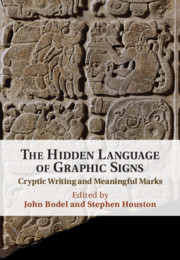Book contents
- The Hidden Language of Graphic Signs
- The Hidden Language of Graphic Signs
- Copyright page
- Contents
- Contributors
- Abbreviations
- Introduction
- Part I Hidden Writing
- One Buried and Camouflaged Writing in Early China
- Two Dazzled and Absorbed
- Three Impossible Unities
- Four Inscribe and De-scribe/Cipher and De-cipher
- Five Script, Pseudoscript, and Pseudo-pseudoscript in the Work of Filippo Lippi
- Six Numerals as Letters
- Part II Legible Signs
- References
- Index
One - Buried and Camouflaged Writing in Early China
from Part I - Hidden Writing
Published online by Cambridge University Press: 23 August 2021
- The Hidden Language of Graphic Signs
- The Hidden Language of Graphic Signs
- Copyright page
- Contents
- Contributors
- Abbreviations
- Introduction
- Part I Hidden Writing
- One Buried and Camouflaged Writing in Early China
- Two Dazzled and Absorbed
- Three Impossible Unities
- Four Inscribe and De-scribe/Cipher and De-cipher
- Five Script, Pseudoscript, and Pseudo-pseudoscript in the Work of Filippo Lippi
- Six Numerals as Letters
- Part II Legible Signs
- References
- Index
Summary
This introductory essay lays out the concept of “hidden” writing, which, by its formal intricacy, deflects attention from language. It also addresses semasiography, systems of marking with visual signs. The aim is to explore modes of graphic communication often thought to be secondary to writing as a purely phonic record. In fact, these complex forms and codified signs operate alongside and beyond language, overlooked yet as compelling and omnipresent as phonic writing itself. These graphs are situated in relation to, but as distinct from, research on “cultural graphology” (Jacques Derrida), “graphesis” (Johanna Drucker), and “the graphosphere” (Armando Petrucci). Evidence to make our points comes from palaeography and steganography, along with notations as diverse as Otto Neurath’s “Isotype,” Xu Bing’s emoji narrative, and Inka khipu knot notations.
- Type
- Chapter
- Information
- The Hidden Language of Graphic SignsCryptic Writing and Meaningful Marks, pp. 19 - 40Publisher: Cambridge University PressPrint publication year: 2021

